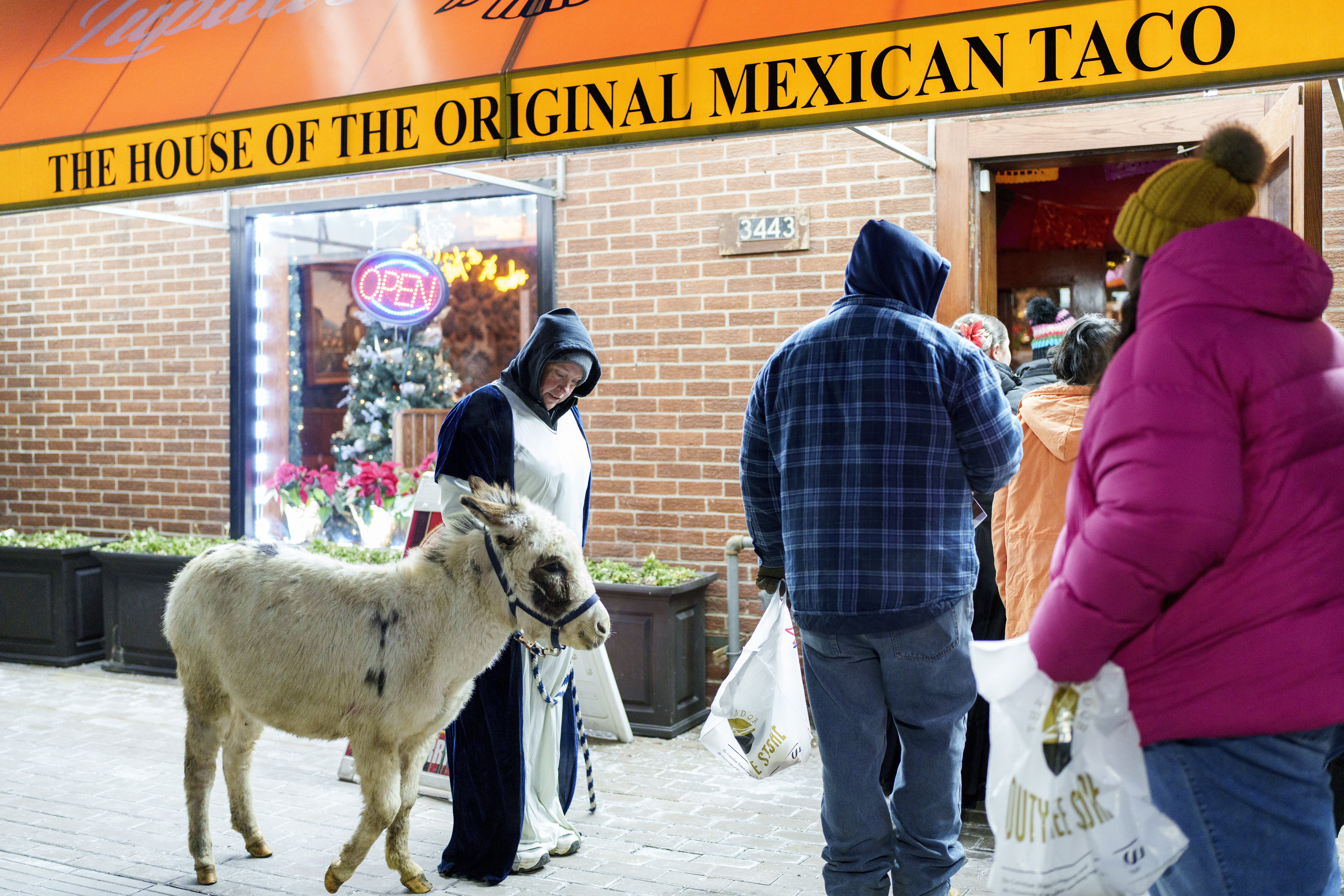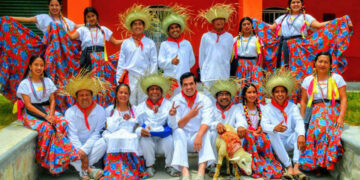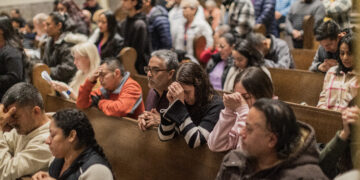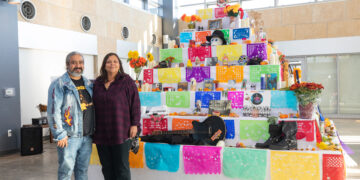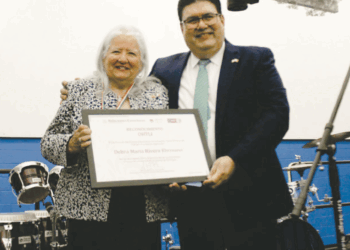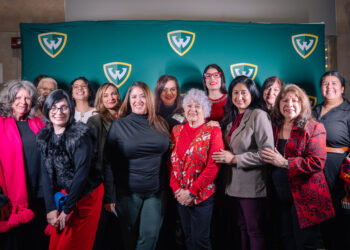Eighty years after Norman Rockwell painted Freedom from Want, a painting of a family gathered around a dinner table for a holiday meal, Latinos from Southwest Detroit are serving a different kind of dinner, one where Mexicans serve atole instead of eggnog, where Puerto Ricans serve mashed plantains (mofongo) instead of mashed potatoes, and Salvadorians serve pupusas instead of cornbread. For immigrants, these savory dishes herald feelings of longing for their homeland and what it’s like to adopt a new country.
Today, when Latino immigrants gather for Thanksgiving, they set a table diverse with food from their ancestral lands just south of the border and feed their families with bounties rich in history. Venezuelans serve arepas, Guatemalans prepare tamales made with banana leaves, and Mexicans can’t have a holiday without pozole, an Aztec dish with a thousand years of history.
One of the reasons to serve such traditional foods is that “most newer generations don’t go back [to theircountry of origin], so food is a way to connect them to their roots,” said Maria Tolentino, from the Dominican Republic, who has been in the U.S. for 37 years.
Thanksgiving is a holiday where the gift you give is that of gratitude. Latinos often profess to be grateful for a roof over their heads, health, and food on the table, such as corn, chocolate, and chiles—staples that are the currency of indigenous Latino cuisine.
Most immigrants come to the United States out of necessity, fleeing violence or poverty and looking for opportunity and education.
Being an immigrant during the holiday can often feel like you are a child of divorced parents, where you have two different homes, two different experiences, and longing for a time when your family was all together. It’s a hopeful way of saying I can be an American and retain my culture and traditions, as well as togetherness in a time when such things are a precious commodity.
“Thanksgiving brings people together—an invitation of all people, races, and cultures. So we bring the dishes closest to our hearts to share in that melting pot,” said Sonja Olmeda, whose family is from Puerto Rico.
During this year’s festivities, remember that regardless of how far you’ve come or where you’d like to be next year, don’t forget to enjoy a tooth-breakingchocolate de abuelitabest steeped in hot milk.For a taste of Central American holiday cuisine, Southwest Detroit has many foods to satisfy your Thanksgiving cravings.
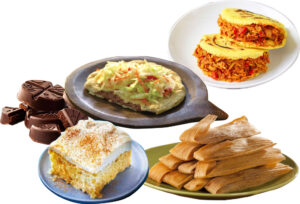
For a twist on a classic, visit a Hispanic-owned business with menus consisting of authentic holiday recipes. El Rey De las Arepas on McGraw has savory arepas, and Pupuseria Y RestauranteSalvadoreño on Livernois has fresh pupusas and traditional Salvadorean food. La Fiesta on Vernor has sugar cane and all of your baking needs – whether you whip up a tres leches cake, flan, or a pumpkin pie.
If you hope to have authentic Mexican or Central American food without the hassle of cooking, a simple social media search will point you to pop-up shops and delivery services, from sweet treats to delicious eats. Ari’s Eats N Treats on Facebook, run by Ariana Rendon, is one such business that will have you ready for the holidays and further proves that a bit of foodie magic can go a long way.
When Latinos gather, the table brims with food from our ancestral grounds. Tradition can be remixed. Old favorites can become new again. After all, when life hands you a turkey, you make turkey tamales.
Estefania Arellano-Bermudez is a lifelong Detroiter. She has published in the Telegram News and believes words evoke magic.
This story was made possible by the Race and Justice Reporting Initiative. The goal of the initiative is to build trust between the news media and Black, Indigenous, and People of Color communities and strengthen representative democracy.
Los latinos le estamos poniendo nuestro sabor a una tradición estadounidense
Han pasado ochenta años desde que Norman Rockwell pintó Freedom from Want, el cuadro de una familia reunida alrededor de una mesa en un día festivo, pero los latinos del suroeste de Detroit están sirviendo una cena diferente, una en la que los mexicanos toman atole en lugar de ponche de huevo, mientras que los puertorriqueños sirven puré de plátanos (mofongo) en lugar de puré de papas, y los salvadoreños sirven pupusas en lugar de pan de maíz. Para los inmigrantes, estos sabrosos platos presagian sentimientos de añoranza por su patria y lo que es adoptar un nuevo país.
Cuando los inmigrantes latinos se reúnen el Día de Acción de Gracias, preparan una mesa variada con comida de sus tierras ancestrales del sur de la frontera y alimentan a sus familias con productos ricos en historia. Los venezolanos sirven arepas, los guatemaltecos preparan tamales con hojas de plátano y los mexicanos no pueden pasar una festividad sin pozole, un plato azteca con mil años de historia.
Una de las razones para servir alimentos tan tradicionales es que “la mayoría de las nuevas generacionesno regresan a su país de origen, por lo que la comida es una forma de conectarse con sus raíces”, dijo María Tolentino, de República Dominicana, quien ha estado en los EE. UU. durante 37 años.
El Día de Acción de Gracias es una festividad en la que el regalo que se da es el de gratitud. Los latinos a menudo profesan estar agradecidos por tener un techo sobre sus cabezas, salud y comida en la mesa, como maíz, chocolate y chiles, alimentos básicos que son la moneda de cambio de la cocina indígena latina.
La mayoría de los inmigrantes vienen a Estados Unidos por necesidad, huyendo de la violencia o la pobreza y buscando oportunidades y educación.
Ser inmigrante durante las festividades a menudo puede sentirse como ser hijo de padres divorciados, donde hay dos hogares diferentes, dos experiencias diferentes y se anhela un momento en el que la familia esté junta. Es una forma esperanzadora de decir que se puede ser estadounidense y conservar la cultura y tradiciones, así como la unión en una época en la que esas cosas son un bien preciado.
“El Día de Acción de Gracias une a las personas: es una invitación a todas las personas, razas y culturas. Así que se traen los platillos más cercanos a nuestro corazón para poder compartirlos”, dijo Sonja Olmeda, cuya familia es de Puerto Rico.
Durante las festividades de este año, sin importar lo lejos que haya llegado o dónde le gustaría estar el próximo año, no olvide disfrutar de un delicioso Chocolate Abuelita.

Para probar la cocina centroamericana, el suroeste de Detroit tiene mucha comida para satisfacer sus antojos de Acción de Gracias. Para darle un giro a un clásico, visite un negocio de propiedad hispana con menús que consisten en auténticas recetas festivas. El Rey De las Arepas en McGraw tiene arepas sabrosas, y Pupuseria Y Restaurante Salvadoreño en Livernois tiene pupusas frescas y comida tradicional salvadoreña. La Fiesta en Vernor tiene caña de azúcar y todo lo que necesita para hornear, ya sea que prepare un pastel de tres leches, un flan o un pastel de calabaza.
Si desea disfrutar de auténtica comida mexicana o centroamericana sin la molestia de cocinar, una simple búsqueda en las redes sociales le indicará tiendas temporales y servicios de entrega, desde dulces hasta comidas deliciosas. Ari’s Eats N Treats en Facebook, dirigido por Ariana Rendon, es uno de esosnegocios que lo mantendrá listo para las fiestas y demuestra además que un poco de magia gastronómica puede ser de gran ayuda.
Cuando los latinos se reúnen, la mesa rebosa de comida de nuestra tierra. La tradición se puede remezclar. Los viejos favoritos pueden volver a ser nuevos. Después de todo, cuando la vida te entrega un pavo, haces tamales de pavo.
Estefania Arellano-Bermúdez Detroitina de toda la vida. Ha publicado en Telegram News y está segura que las palabras evocan magia.
Este articulo fue posible gracias a Race and Justice Reporting Initiative. El objetivo de la iniciativa es generar confianza entre los medios de comunicación y las comunidades negras, indígenas y de color y fortalecer la democracia representativa.
Traducción Carmen Elena Luna

